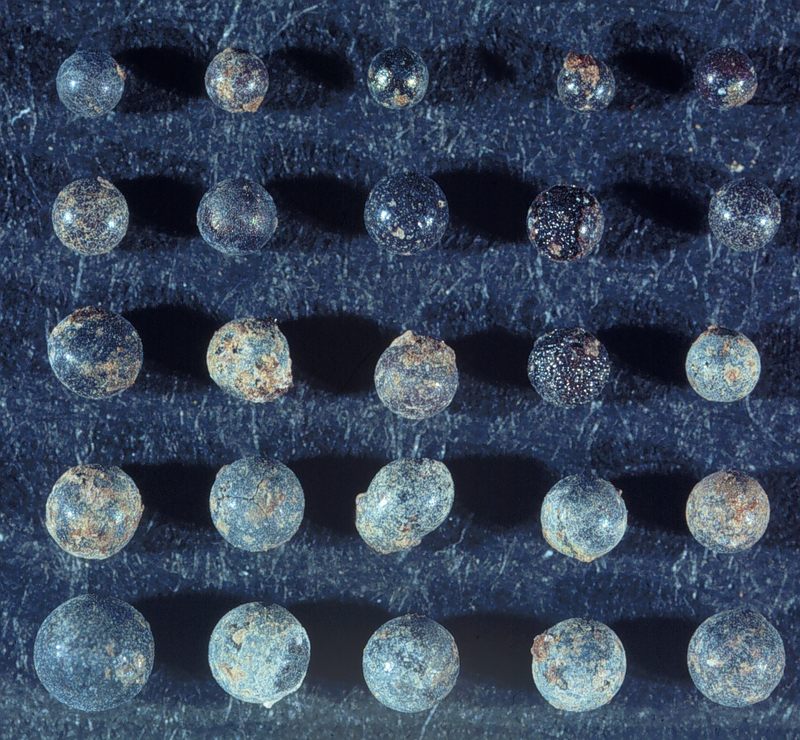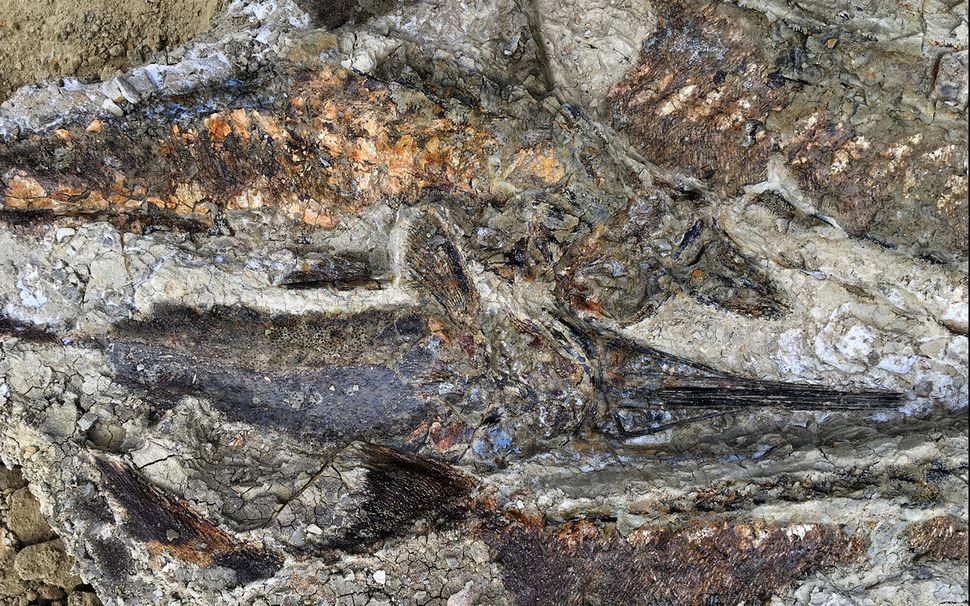The Terrifying Truth About the Day the Dinosaurs Died
 |
| The glass balls or "tektites" that set the earth on fire 66 million years ago. |
For the most part, we've all heard some variation of theory to explain the extinction of the dinosaurs. We all know about the infamous Chicxulub asteroid (the origin of which is still a mystery; some believed it to be a remnant of a large asteroid called "Baptistina," but this may no longer be true). This traditional theory suggested that a large asteroid hit Earth near the Gulf of Mexico and and this impact kicked up a huge cloud of dust and particles that covered the Earth and sent it into something of an ice age, rapidly changing the climate in such a way that most of life on Earth died out. A new theory has been floating around recently that suggests that this may not be the whole story.
All around the world, deep underground, there is a dark, grey line of mudstone called the KT Boundary, which is rich in something called Iridium, which is thought to have been brought to Earth by the Chicxulub asteroid. We have realized something odd about this line. Specifically, all species of dinosaurs ever discovered have been found below this line, but not a single specimen (so far) has ever been found above that line. Anyone familiar with geology may know what this suggests: no non-avian dinosaur ever survived the KT extinction event. This further suggests that whatever killed the dinosaurs was sudden and fast and not solely the long, chilly winter we once thought it to be. So what exactly happened on Earth those millions of years ago?
Rewinding back 66 million years ago, we are transported to a (most likely) very hot, summer day in June or July. We get this timeline by looking at the fossils of lotuses and water lilies. The extinction event occurred between the flowering of both species, placing us sometime in June or July. Dinosaurs are living all across the planet and are clearly the dominant species on Earth. An asteroid the size of Mount Everest is hurtling towards them at speeds faster than a speeding bullet and its impact will change Earth's natural history forever. As the asteroid is hitting the planet, it pushes the gases of the atmosphere aside, temporarily creating a hole. It hits the ground with the energy equivalent of 100 million megatons. This is the same as 100 million hydrogen bombs (with each hydrogen bomb being the equivalent of 1 million tons of TNT) all exploding in the same spot.
Around the impact site, the temperature reaches around 20,000 degrees, which is four times hotter than the sun (the sun is 5,000 degrees). This asteroid hurtles into the ground 20 miles, shooting back all of the rock and dust that it's plowed through straight up into the sky and through the atmosphere as a giant cloud of rock gas. This gas cools down and slows down in outer space, turning into little glass balls called "tektites." Meanwhile, down on the ground, the impact has caused massive earthquakes and simultaneously, massive tsunamis that flood the land in some areas, burying marine animals and terrestrial and freshwater animals alike into one large tomb. As the Earth hurtles through space, its gravity attracts the floating glass balls back down to it on all sides of the planet. Many of the glass balls burn up in the atmosphere. This is where it gets...scary.
At the same time as the earthquakes and tsunamis (which at this point, I believe are not worldwide), this cloud of glass balls is raining down on Earth, burning up in the atmosphere, and turning the color of the sky into a frightening red. It may have looked like one of the most intense meteor showers ever seen. Each glass ball that burns up adds a little bit of heat to the atmosphere, and these balls add up. Within maybe about 15 minutes of the asteroid hitting Earth, temperatures would start rising from what could have already been a very warm 100+ degree day. Within in an hour, the temperature of the planet would've topped out at 1,200 degrees, or about the temperature of a pizza oven. At this temperature, your blood would boil and you would die. Some scientists suggest that this event, which would've taken only a few hours, would've killed nearly all of the dinosaurs, if not all. Floods. Earthquakes. Forest fires. An unimaginably hot and hellish environment. This is what the entire planet would've been like. It's not difficult to imagine that all of the dinosaurs could've died out within just a few hours once you take that into consideration.
The extinction of prehistoric marine animals could've happened as the result of a longer period of cooling temperatures as a cloud of sulfur and other particles cover the skies, kicked up by the asteroid. Most of the animals in the ocean would've needed warmer waters to survive, so they died out. This vacuum of life would eventually lead to the rise of mammals, of which the earliest were most likely small, rodent-sized creatures that were able to survive the intense heat, fires, and food shortages by heading underground and eating insects and seeds (this statement is my own theory).
 |
| Fish fossils from the Tanis site in North Dakota |
This theory was created as a result of a series of experiments and studies, so I know what you're thinking: "where's the proof?" In North Dakota, a fossil site (dubbed "Tanis") was discovered that some claim has evidence to support this theory. At this site, both marine animals and freshwater animals were discovered, stacked on top of each other like logs and washed together by the aforementioned tsunamis. Some were even pinned to trees (the stumps of which were discovered to be charred, most likely from the intense, worldwide forest fires experienced on that day). Many other animals were discovered in the area, but only one dinosaur bone has so far been found: a hip bone (which is rumored to still have skin on it). If the claim that this site captures the events of the KT event is real, that bone likely belongs to the youngest dinosaur ever found. To further validate this site, in the gills of many of the fish fossils found there were the same tektites, or glass balls, that rained down on that tragic, terrifying day.
So, is this it? Was this what really did the dinosaurs in? Is the 65 million year old cold case finally solved? Well, perhaps...but also, perhaps not. The truth is, we may never know what really happened, at least in our lifetimes. This theory, though convincing to many such as myself, is still just a theory (and one of many) and the widespread conflicting theories and facts going around makes it difficult to establish what's true and what's not. Still, it's truly an amazing thing to think about. Mass extinction events in general are such terrifying and grand things and we can learn much about our world today by studying the world of the past. All manners of strange and wonderful creatures and plants lie underground, waiting for us to meet them and learn about them. Natural history may be boring to some, but I see great value in learning from these ancient worlds. Do you?
Some sources:
- https://www.wnycstudios.org/story/dinopocalypse-redux - Radiolab
- https://dailygalaxy.com/2019/03/the-day-the-earth-rained-glass-prelude-to-extinction/
- https://www.nasa.gov/mission_pages/WISE/news/wise20110919.html
- https://www.livescience.com/65132-cretaceous-death-pit-tanis.html
- https://www.netflix.com/title/81121175 - Day the Dinosaurs Died - movie
~ Danny (DarylOnABarrel)

Very well written! Question though.....how and where does this fit into our faith and how God created the world and everything in it? I'm curious.
ReplyDeleteThanks! Well, I can’t say I know the actual teachings on these subjects, but I wouldn’t think too hard about it. Your faith shouldn’t be in conflict after reading something like this. The universe is huge and ancient. There’s a whole world that’s existed before us, and our faith helps us connect with God and the world as we’ve known for as long as we’ve been around. It won’t necessarily cover things like this, but it doesn’t have to. Just like how the Bible doesn’t mention penguins or koalas but clearly they exist. Understanding why the dinosaurs died is important for many reasons, but I wouldn’t argue that it’s a vital thing to understand for your faith. Hope this stream-of-consciousness answer addresses your question, lol.
DeleteYeah it does :)
Deletedino die make me sad.uwu
ReplyDeletetears.jpg
DeleteSuper interesting to think about!! Thanks for the cool read
ReplyDeleteYou're welcome! Thanks for reading!
Delete